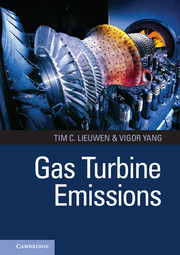Book contents
- Frontmatter
- Contents
- List of Contributors
- Foreword
- Preface
- Part 1 Overview and Key Issues
- Part 2 Fundamentals and Modeling: Production and Control
- 5 Particulate Formation
- 6 Gaseous Aerosol Precursors
- 7 NOx and CO Formation and Control
- 8 Emissions from Oxyfueled or High-Exhaust Gas Recirculation Turbines
- Part 3 Case Studies and Specific Technologies: Pollutant Trends and Key Drivers
- Index
- References
8 - Emissions from Oxyfueled or High-Exhaust Gas Recirculation Turbines
from Part 2 - Fundamentals and Modeling: Production and Control
Published online by Cambridge University Press: 05 June 2013
- Frontmatter
- Contents
- List of Contributors
- Foreword
- Preface
- Part 1 Overview and Key Issues
- Part 2 Fundamentals and Modeling: Production and Control
- 5 Particulate Formation
- 6 Gaseous Aerosol Precursors
- 7 NOx and CO Formation and Control
- 8 Emissions from Oxyfueled or High-Exhaust Gas Recirculation Turbines
- Part 3 Case Studies and Specific Technologies: Pollutant Trends and Key Drivers
- Index
- References
Summary
Introduction
This chapter discusses emissions from systems with extensive levels of exhaust gas recirculation (EGR) or that use oxygen rather than air as a reactant (referred to here as oxyfuel combustion). Such systems have unique attributes that warrant a dedicated chapter in this treatment. First, the systems in which EGR or oxyfuel would be deployed have different degrees of freedom and requirements. For example, both are prominent candidates for carbon capture and storage (CCS) (Griffin et al., 2008; Budzianowski, 2010), where emissions requirements are driven by pipeline or geologic reservoir constraints rather than by atmospheric pollution considerations. Second, while CO2 and H2O dilution have been discussed in Chapters 5 and 7, their presence at very high levels in systems with EGR can provide a significant perturbation of the nominal reactant kinetics (such as in the radical pool) and requires a focused treatment.
As noted earlier, EGR and oxyfuel combustion for gas turbine applications are promising approaches to implement CCS in gas turbine power plants. EGR has also been proposed as a means of promoting fuel flexibility (enabling use of fuels with low heating value (Danon et al., 2010) and high hydrogen content (Lückerath et al., 2008)), and for increasing static stability (resistance to flashback/blowout) (Kalb and Sattelmayer, 2004) and dynamic stability (ElKady et al., 2009) relative to lean premixed combustors, while enabling low levels of pollutant emissions.
- Type
- Chapter
- Information
- Gas Turbine Emissions , pp. 209 - 234Publisher: Cambridge University PressPrint publication year: 2013
References
- 3
- Cited by



